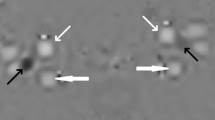Summary
Using parietal cranial windows and multichannel videoangiometry, pial vessel responses were studied in cats during stepwise elevation of superior sagittal sinus pressure (PSSS) to a level of 50 mmHg or reduction of CSF-pressure (PCSF). PCSF was monitored via a needle in the great cistern, known from previous studies to be identical to supratentorial CSF-pressure. During elevation of PSSS, large and small pial veins dilated by 14±6.1% from resting diameter. Small arteries remained unresponsive until they were dilated by 9±2.1% at the level of PSSS 50mmHg. Large arteries dilated by 18±5.5% at the level of PSSS 50 mmHg. PSSS was always approximately twice as high as PCSF during increase of PSSS. During reduction of PCSF to
− 5 mmHg, pial veins also dilated, by 7.4±1 % on the average. This observation suggests that normal PCSF is a result of mainly venous vascular pressure, and that the level of normal venous pressure is not dictated by PCSF but by the function and architecture of the cerebral vasculature. Since the rapid reduction of cerebral perfusion pressure CPP by elevation of venous pressure does not induce autoregulatory adjustment according to the level of CPP, but to the level of arterial transmural pressure, it is concluded, that the basic mechanism underlying autoregulation of CBF is myogenic.
Similar content being viewed by others
References
Auer LM, Haydn F (1979) Multichannel videoangiometry for continuous measurement of pial microvessels. Acta Neurol Scand 60 [Suppl 72]: 208–209
Auer LM, Ishiyama N (1986) Cerebrovascular response to elevated intracranial pressure. In: Miller JD, Teasdale GM, Rowan JO, Galbraith SL, Mendelow AD (eds) Intracranial pressure VI. Springer, Berlin Heidelberg New York, pp 399–403
Auer LM, Ishiyama N, Pucher R (1987 a) Cerebrovascular response to intracranial hypertension. Acta Neurochir (Wien) 84: 124–128
Auer LM, Pucher R, Leber K, Ishiyama N (1987 b) Autoregulatory response of pial vessels in the cat. Neurol Res 9:245–248
Bayliss WM (1902) On the local reactions of the arterial wall to changes of internal pressure. J Physiol 28: 220–231
Benabid AL, Persat JC, de Rougoment Jet al (1978) Intracranial pressure IV—relationship with post capillary vascular pressures. J Physiol 74: 369–378
Emerson TE, Parker JL (1975) Effect of local increases of venous pressure on canine cerebral hemodynamics. In: Langfitt TW, McHenry L, Reivich M, Wollman H (eds) Cerebral circulation and metabolism. Springer, Berlin Heidelberg New York, pp 10–13
Kontos HA, Wei EP, Navari RM, Levasseur JE, Rosenblum WI, Patterson JL (1978) Responses of cerebral arteries and arterioles to acute hypotension and hypertension. Am J Physiol 234: H 371-H 383
MacKenzie ET, Strandgaard S, Graham DI, Jones JV, Harper AM, Farrar JK (1976) Effects of acutely induced hypertension in cats on pial arteriolar caliber, local cerebral blood flow, and the blood-brain barrier. Circ Res 39: 33–41
MacKenzie ET, Farrar JK, Fitch W, Graham DI, Gregory PC, Harper AM (1979) Effects of hemorrhagic hypotension on the cerebral circulation. I. Cerebral blood flow and pial arteriolar caliber. Stroke 10: 711–718
Morii S, Nagai AC, Winn HR (1986) Reactivity of rat pial arterioles and venules to adenosine and carbon dioxide: with detailed description of the closed cranial window technique in rates. J Cereb Blood Flow Metab 6: 34–41
Sadoshima S, Thames M, Heistad D (1981) Cerebral blood flow during elevation of intracranial pressure: role of sympathetic nerves. Am J Physiol 10: H 78-H 84
Wagner EM, Traystman RJ (1983) Effects of cerebral venous and cerebrospinal fluid pressure on cerebral blood flow. In: Auer LM, Loew F (eds) The cerebral veins. An experimental and clinical update. Springer, Wien New York, pp 223–230
Winn HR, Rubio R, Berne RM (1981) The role of adenosine in the regulation of cerebral blood flow. J Cereb Blood Flow Metabol 1: 239–244
Yada K, Nakagawa Y, Tsuru M (1973) Circulatory disturbance of the venous system during experimental intracranial hypertension. J Neurosurg 39: 723–729
Author information
Authors and Affiliations
Rights and permissions
About this article
Cite this article
Pucher, R., Kato, Y., Mokry, M. et al. Cerebrovascular response to changes of cerebral venous pressure and cerebrospinal fluid pressure. Acta neurochir 109, 52–56 (1991). https://doi.org/10.1007/BF01405698
Issue Date:
DOI: https://doi.org/10.1007/BF01405698




